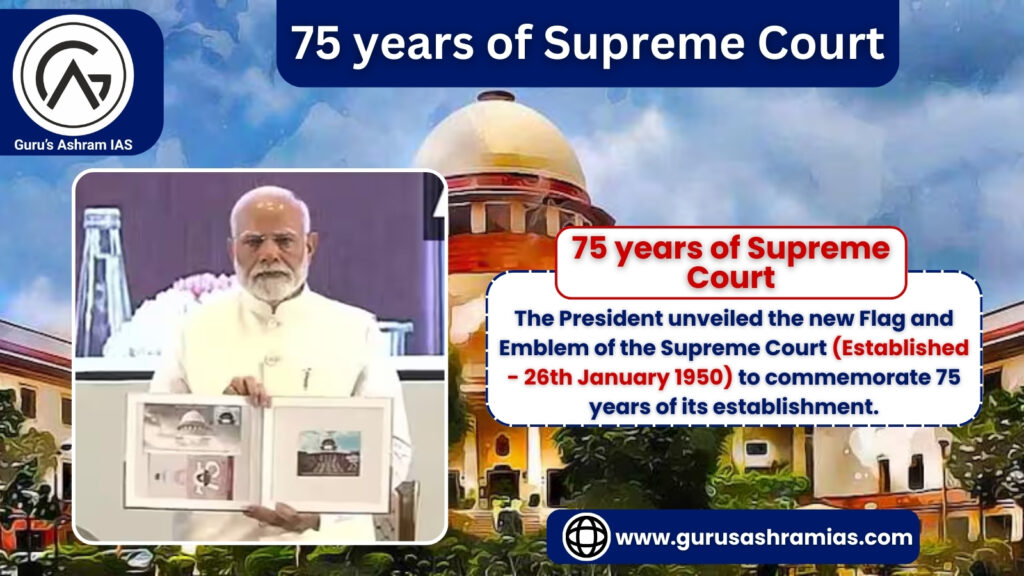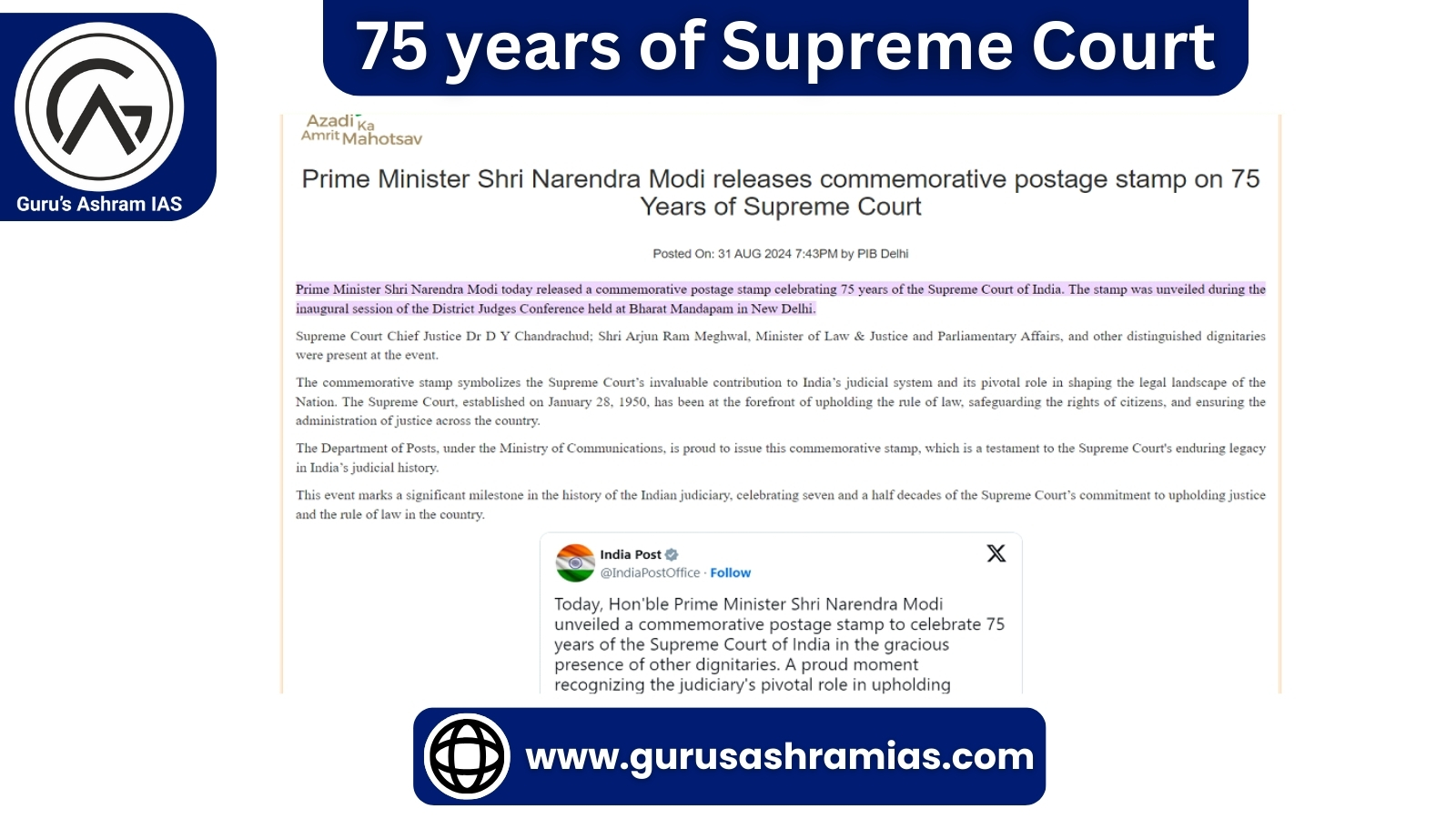75 years of establishment of Supreme Court
- Recently, the President unveiled the new Flag and Emblem of the Supreme Court (Established – 26th January 1950) to commemorate 75 years of its establishment.
- The flag is inscribed with the Ashoka Chakra, the Supreme Court building and the book of the Constitution of India.
- The Prime Minister also released a commemorative postage stamp to mark the 75th anniversary of the Supreme Court of India.
Role of the Supreme Court for 75 years:
Role of judiciary in strengthening democracy:
- The judiciary in India has played an important role in safeguarding democracy and liberal values since independence.
- It has acted as a guardian of the Constitution, a defender of the rights of the marginalized and an anti-majoritarian governing body.
Development of Supreme Court (SC):
- The journey of the Supreme Court and its role in strengthening democracy and protecting individual liberty can be categorized into four phases.
Focus on judicial review:
- In the early years after independence, the judiciary maintained a conservative approach and confined itself to the written interpretation of the Constitution.
- It used judicial review to examine legislative actions without overstepping its bounds.
Protection from ideological influences:
- The judiciary avoids being influenced by government ideologies such as socialism and affirmative action.
- For example, in the Kameshwar Singh case, 1952, the abolition of zamindari was declared illegal, but the constitutional amendments made by Parliament were not invalidated.
Respect for Legislative Supremacy:
- Cases such as the Champakam Dorairajan case, 1951 show that the judiciary rejected reservations in educational institutions in violation of the right to equality but avoided confrontation with Parliament by adhering to a positive interpretation of the Constitution.
Expansion of Fundamental Rights:
- The Golak Nath judgment, 1967 marked a shift towards a more expansive interpretation of fundamental rights, which challenged the legislative power of Parliament and re-emphasised the power of judicial review.
- In the Golak Nath case, 1967, the Supreme Court had ruled that Parliament cannot take away or abridge any fundamental right.
The historic decision on the constitutional amendment:
- The Supreme Court’s decision in the Kesavananda Bharati case, 1973, introduced the ‘basic structure’ doctrine, which limited the power of Parliament to amend the Constitution, leading to a confrontation between the judiciary and the executive.
Impact of Emergency on Judicial Independence:
- The national emergency and the appointment of Justice A.N. Ray as the Chief Justice of India, bypassing three senior-most judges, contributed majorly to the judicial capitulation in ADM Jabalpur v. Shivakant Shukla, 1976, which upheld the government’s act of suspending the right to life under Article 21 of the Fundamental Rights.
- The judgment marked a new low for constitutional democracy in the country, while also exposing the institutional weakness of the higher judiciary.
Corrections after an emergency:
- After the Emergency, the judiciary attempted to regain its independence and credibility. The Maneka Gandhi case, 1978 broadened the interpretation of Article 21 and expanded the scope of right to life and personal liberty.
Rise of Public Interest Litigation (PIL):
- Through cases like the Hussainara Khatoon case, 1979, the judiciary expanded access to justice by allowing public interest individuals to file petitions on behalf of marginalized groups.
- Public interest litigations became an instrument of judicial activism, addressing issues such as human rights, environmental protection and governance.
The collegium system:
- The judiciary tried to maintain its autonomy by introducing the collegium system for the appointment of judges.
- This system was later challenged by the National Judicial Appointments Commission Act, 2014, which was struck down by the judiciary to protect its independence.
Generous explanation:
- The Supreme Court has upheld the abrogation of Article 370 for the full integration of Jammu and Kashmir into the Indian Union.
Maintaining judicial activism:
- Despite criticisms, the judiciary has continued to assert its role in protecting constitutional rights. For instance, the Supreme Court invalidated the opaque electoral bond scheme.
- In 2018, the Supreme Court struck down Section 497 of the Indian Penal Code, which declared adultery a crime violating Article 14.
Phase I (1950-1967):
- It reflected compliance with the constitutional text and judicial restraint.
Second phase (1967-1976):
- Was marked by judicial activism and confrontation with Parliament.
Third phase (1978-2014)
- It demonstrated judicial activism and expansion of Public Interest Litigation (PIL).
Phase IV (2014-present):
- It focused on liberal interpretation of the Constitution and treating the Constitution as a living document.
The main challenges before the Supreme Court:
Number of Pending Cases:
- There were 80,439 cases pending in the Supreme Court at the end of the year 2023. These pending cases cause substantial delay in delivery of justice which undermines the efficiency and credibility of the judiciary.
Dominance of Special Leave Petitions (SLPs):
- The highest number of cases in the list of cases pending before the Supreme Court pertain to Special Leave Petitions (Preferential Means for Civil and Criminal Appeals), which are paramount to other types of cases such as writ petitions and constitutional challenges.
- This preference affects the court’s ability to effectively resolve a wide variety of issues.
Selective preference of cases:
- The ‘pick and choose model’ allows some cases to take precedence over other cases, leading to the perception of preferential behaviour. For example, a high-profile bail application is fast-tracked compared to other important cases.
Judicial Avoidance:
- Pending cases sometimes lead to ‘Judicial Avoidance’, where important cases are deferred or delayed. Notable examples include the Aadhaar biometric ID scheme challenge and the delay in adjudicating the electoral bonds case.
Conflict of Interest and Integrity:
- Allegations of corruption within the judiciary, including the Supreme Court, pose challenges to its integrity and public trust.
- For example, a potential conflict of interest came to the fore when Justice Abhijit Gangopadhyay of the Calcutta High Court resigned from his post as a judge and entered politics shortly after.
Judges Appointment Concerns:
- The process of judicial appointments, especially the role of the collegium system, has been a subject of controversy.
- Reforms like the National Judicial Appointments Commission have been discussed to make the appointment process more transparent and accountable.
Solution:
All India Judicial Recruitment:
- Recently the President called for judicial recruitment at all India level. Setting a national standard for judicial recruitment ensures uniformity and quality across states, thereby improving efficiency.
- Judicial appointments in district courts should no longer be limited by domestic constraints such as the narrowness of regionalism and the limitations of state-centric selections.
Improving case management:
- There is a need to implement advanced case management techniques to streamline processes.
- The e-Courts project, for instance, aims to digitise and automate court operations, which can help manage case backlogs and reduce delays.
- Expanding the use of the Supreme Court’s Case Management System (CMS) to enhance the tracking and management of cases.
Promoting Alternative Dispute Resolution (ADR):
- Encourage the use of ADR mechanism for cases which do not require the intervention of the Supreme Court, as laid down in the Arbitration and Conciliation Act, 1996.
Transparent Case Listing:
- Develop transparent case listing and prioritization protocols.
- The Supreme Court portal may include a facility to publicly track the status and priorities of cases, which will ensure transparency.
Defining the institutional objectives:
- Clearly define and communicate organizational goals. The judicial performance appraisal framework can be adapted to assess and realign the goals of the court.
- The Research and Training Institute of the Supreme Court can play a role in supporting this focus.
Strengthening of Accountability Mechanism:
- Enforce strict accountability measures for judges. For example, set up an independent Judicial Accountability Commission for government officials on the lines of the Central Vigilance Commission.





